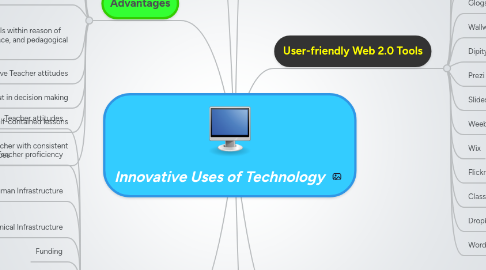Innovative Uses of Technology
by Belinda Whitaker

1. Limitations
1.1. Teacher attitudes
1.1.1. Digital immigrants
1.1.2. Afraid of change
1.2. Teacher proficiency
1.3. Lack of Human Infrastructure
1.3.1. Technical Support
1.3.2. Administrative Support
1.4. Inadequate Technical Infrastructure
1.5. Funding
1.6. Limited resources
1.7. Distance from school culture
1.8. Time
1.9. Ineffective Professional Development
1.10. Lack of Communication
1.11. Social connections
1.12. Focus on Standardized Testing
1.13. Lack of trust
1.14. Conflicting pedagogical practices
1.15. Lack of detail in project implementation
1.16. Dependent upon others
2. Advantages
2.1. Information Age (click of a button)
2.2. Supportive Administration, Staff and Collaboration
2.3. Effective Professional Learning Communities
2.4. Grants
2.5. Customized Professional Development
2.6. World Wide Web
2.6.1. Freeware
2.6.2. Tons of online resources and materials
2.7. Clear, obtainable goals within reason of school culture, distance, and pedagogical beliefs
2.8. Positive Teacher attitudes
2.9. Teacher input in decision making
2.10. Self-contained lessons
2.11. Knowledgeable teacher with consistent pedagogical practices
3. Characteristics of an Innovator
3.1. Reflective
3.2. Socially connected
3.3. Active practitioner of pedagogical beliefs
3.4. Technically savvy
3.5. Highly respected by peers
3.6. Promotes teamwork and collaboration
3.7. Effective communicator
4. My Definition
4.1. Personalized learning and differentiation
4.2. Blending learning
4.3. Real-world opportunities reinforced in the classroom
4.4. Project-based activities
4.5. Flipping the classroom
4.6. Global awareness
4.7. Cooperative learning
4.8. Student-centered
4.9. Problem-solving and critical thinking
4.10. Discovery learning
4.11. Virtual classrooms and labs
4.12. Research-based learning
4.13. Real-time collaboration from multiple locations
5. Difference from Traditional Practices
5.1. Learning is extended beyond the school day and school walls
5.2. More collaborative
5.3. Artifacts are created and published electronically and online
5.4. Limited pen and paper activities
5.5. Teachers facilitate rather than lecture
5.6. Students take the reins of learning
5.7. Addresses multiple intelligences and various learning styles
5.8. Easier process for organizing and managing data
5.9. Encourages higher order thinking and real-world application
5.10. Information is accessible any time, any place, and any where
6. Probabilities of Effective Use
6.1. Increase in student achievement
6.2. More innovation in best teaching practices
6.3. Closure in achievement gap
6.4. Parental support and involvement
6.5. Decrease in high-school drop-out rates
6.6. Increase in high-school and college graduates
6.7. More fluent workforce and economy
7. User-friendly Web 2.0 Tools
7.1. Collaborative Applications (Mostly Free)
7.2. Wikis
7.3. Blogs
7.4. Google Apps
7.5. Social Networks
7.6. Private Chat Rooms
7.7. Glogster
7.8. Wallwisher
7.9. Dipity
7.10. Prezi
7.11. Slideshare
7.12. Weebly
7.13. Wix
7.14. Flickr
7.15. ClassJump
7.16. Dropbox
7.17. Wordle


